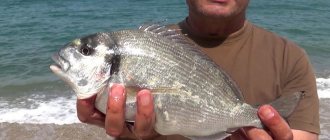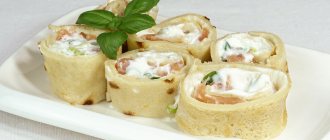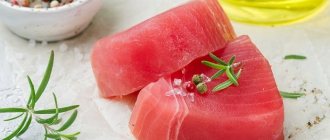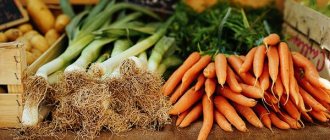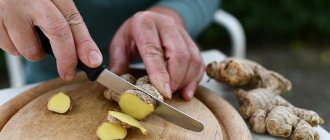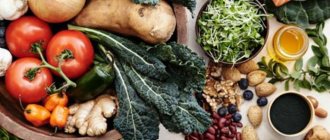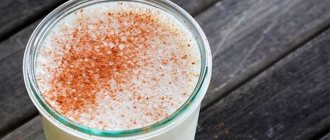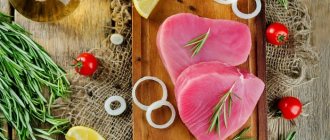Dorado is a favorite delicacy of the inhabitants of Mediterranean countries. The fish is found under different names: golden sparus or spar, chipura, mahi-mahi, dolphin fish, lampuka, coryphaena. In Portugal it is called sea bream, in Italy – orata or aurata, in Russia – sea bream or sea crucian. Dorado means "golden" in Spanish. She received this name because of the golden stripe on her steep forehead. Local residents of some countries believe that spar has magical properties. We’ll tell you which ones in the article and offer several options for preparing fish. You will learn the benefits and harms of sea bream for the human body.
What kind of fish is it, where is it found?
The habitat of the sea bream is the eastern waters of the Atlantic Ocean and the Mediterranean Sea. Less often it can be found off the coast of Crimea in the Black Sea basin. In Spain, Greece, Hawaii and the Caribbean islands, this fish is served at the festive table and treated to tourists.
The Romans knew how to artificially grow it in ancient times, using equipped pools and closed creeks with salt water for these purposes. In the 80s of the last century, Turkey, Greece, and Spain mastered farm breeding. In artificial conditions, the fish are fed with special food in granules; in the natural environment, the predator feeds on seaweed, fry, mollusks and crustaceans.
The life cycle of a dorado is 11 years, during this period it grows to 75-80 cm and gains weight up to 20 kg. Such specimens are considered trophy and are quite difficult to catch. The fish has a recognizable appearance. The oval-shaped body is flattened on the sides, the head has a sharp curve, several sharp jagged scales above the eyes, and between them there is a golden crescent-shaped mark. Dark spots are visible above the gills on both sides. The upper jaw is noticeably longer than the lower jaw, the mouth is narrow with full lips. The body and head are covered with silver-gray scales with a greenish tint, characteristic only of living individuals. Posthumously, the brown patch on the dorsal fin also disappears. The tail is framed by a dark stripe.
Freshly caught
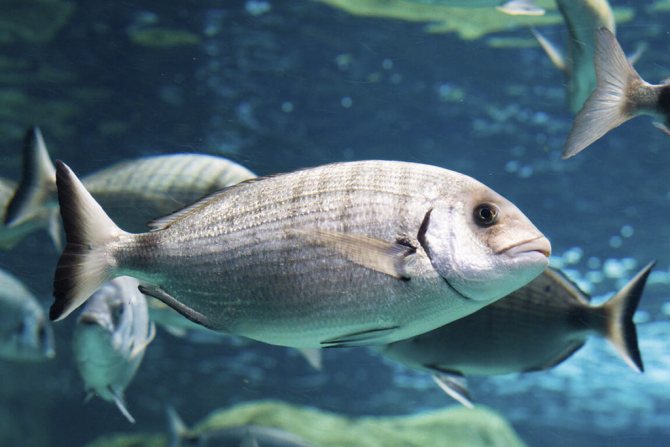
In aquarium
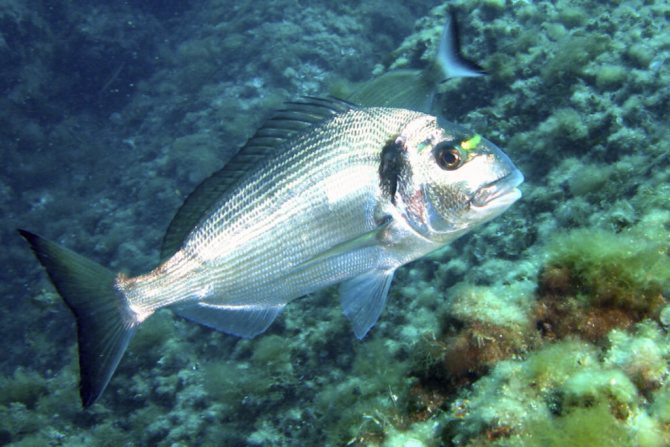
In natural habitat
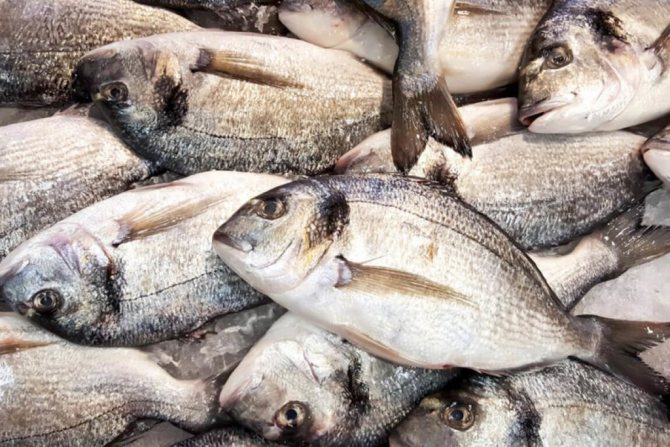
Commercial catch
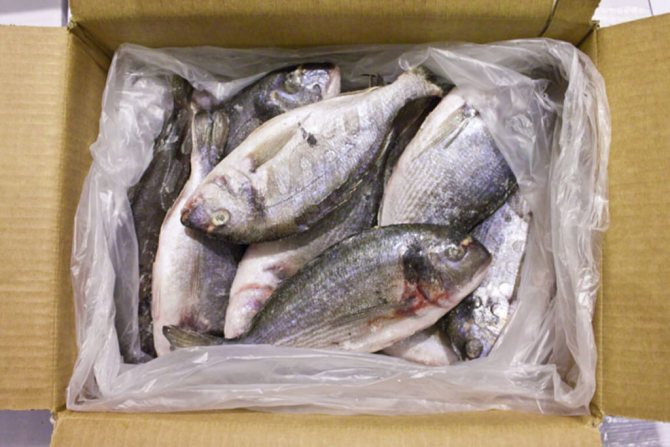
Dorado is imported in this form
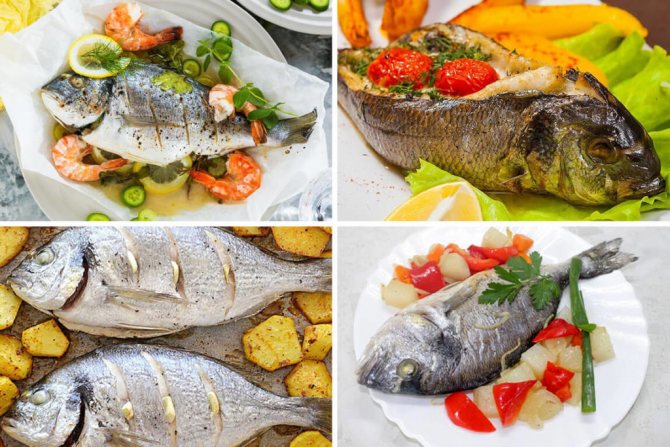
These dishes can be prepared
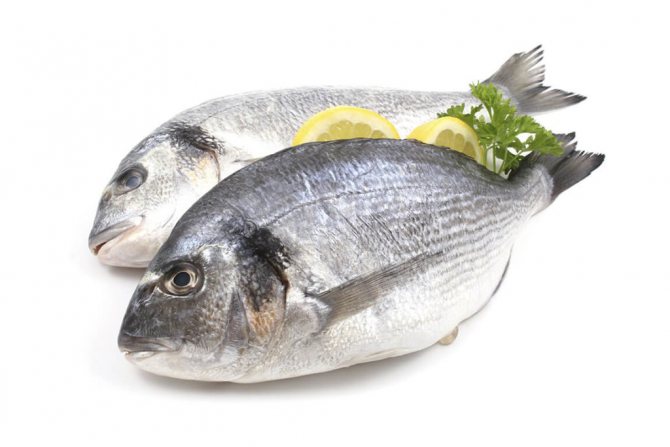
The spawning period is from early October to late December. At this time, the fish descends to a depth of 150 meters, in other months it prefers to be at a level of 10-30 m. Only males are born, which, upon reaching the age of two, degenerate into females.
Beneficial features
Commercial species of dorado:
- royal;
- grey.
The fillet is white, but in the royal it has a pale pink tint. The meat is tender and juicy, with a dense structure and delicate aroma. Thanks to its valuable mineral composition, fish has useful qualities:
- Increases skin elasticity.
- It has a beneficial effect on male reproductive function, increasing sperm production and motility.
- Stimulates the production of thyroid hormones.
- Strengthens joints and bone tissue, prevents tooth decay.
- Speeds up metabolism.
- Promotes timely transmission of nerve impulses.
- Provides blood supply to the brain and peripheral tissues.
- Removes toxins and eliminates the accumulation of toxins.
- Normalizes digestion.
- Stabilizes glucose levels.
- Helps to lose extra pounds.
- Reduces the risk of cognitive impairment.
- Promotes muscle growth in athletes.
- Gives strength and shine to hair.
- Allows you to maintain visual acuity.
Dorado should be consumed in case of severe fatigue and stress to restore lost energy and improve mood.
Benefits and beneficial properties
1. Fish has a lot of meat and very few bones.
2. Low calorie content and a sufficient amount of protein allows you to include dishes from corifena for weight loss.
3. The presence of polyunsaturated fatty acids has a positive effect on the cardiovascular system.
4. Recommended for the prevention of atherosclerosis and normalization of cholesterol levels in the blood.
5. Potassium strengthens the nervous system, heart muscles and normalizes blood pressure.
6. Iodine helps normalize the functioning of the thyroid gland.
7. Iron is necessary to prevent anemia.
8. Zinc is necessary to strengthen the immune system.
9. Sea crucian can be consumed for pancreatitis only in boiled form or steamed cutlets no more than twice a week.
Pregnant and lactating
There is not a single gram of mercury or other heavy metals in sea bream meat, so during pregnancy, the fish will only provide benefits and no harm.
By eating 200-300 g of fillet per day, the expectant mother will receive the entire complex of necessary minerals and vitamins. With systematic use, a woman’s nervousness decreases and gas formation decreases. In addition, micro and macroelements in fish contribute to the correct, timely development of the skeleton and neural tube of the fetus.
Dorado is allowed to be consumed while breastfeeding. But first you should find out whether the child is allergic to the product. To do this, it is enough to eat 100 g of fillet. If within 24 hours the baby does not develop a rash, red spots, or develop a fever, then there are no contraindications.
For nursing women, steamed, stewed or baked fish is healthier.
Is dorado possible for pregnant and lactating women?

Due to the large amount of vitamins and minerals in dorado fish, it can be consumed by pregnant women. You shouldn’t worry about overeating it, because it doesn’t cause harm, only benefit.
As for breastfeeding mothers, fish should be gradually introduced into their diet in small pieces so that the baby does not have an allergic reaction to seafood, as well as colic and tummy pain.
For diseases
Some diseases require strict dietary restrictions. Let's consider cases when bream fish can be included in a patient's diet.
Pancreatitis
When the pancreas is inflamed, the consumption of fats and carbohydrates is minimized. The body requires as much easily digestible animal protein as possible, which dorado is rich in.
Steamed or boiled fish is suitable for the diet. To diversify the diet, it is baked with vegetables without adding oil.
Dorado can be consumed every day for pancreatitis, as it is one of the foods with the lowest fat content. You need to eat in small portions - 70-150 g several times a day.
Diabetes and hyperglycemia
The ability to influence blood sugar levels gives the dorade an advantage over other fish breeds.
When the content of glucose in the blood serum is above 6 mmol/l, including in type 2 diabetes mellitus, low-calorie protein foods are included in the daily diet.
White meat normalizes the patient’s condition and saturates the cells with essential nutrients.
Cardiac ischemia
People who regularly eat dorado are less likely to suffer from coronary artery disease. The minerals contained in fish fillets control coronary blood flow and provide adequate oxygen supply to the myocardium.
Fish should be eaten both for preventive and medicinal purposes. It prevents angina attacks and myocardial infarction.
Useful properties of sea bream
Dorado is a fish that is not only very tasty, but also healthy, one might even say medicinal. It lowers cholesterol levels, increases the elasticity of arteries, preventing atherosclerosis. Due to the high potassium content, brain activity increases, memory improves, and heart function is stimulated. The large amount of iodine contained in sea bream speeds up metabolism, improves immunity, and has a beneficial effect on joints and the thyroid gland. In addition, it contains zinc, copper, boron, fluorine and manganese. It is often recommended to eat sea bream while losing weight. Per 100g of fillet there is an average of only 1.8g of fat, and there are no carbohydrates at all. At the same time, it is rich in protein - approximately 19g. This portion of sea bream contains only 96 kcal, which makes it a truly dietary fish.
Calorie content and composition
There are no carbohydrates in the dorado pulp, but the composition includes fatty acids and chemical elements necessary for life.
100 g of fish contains:
- sulfur – 12 mg;
- potassium – 460 mg;
- phosphorus – 143 mg;
- calcium – 15 mg;
- magnesium – 30 mg;
- sodium – 88 mg;
- copper – 40 mcg;
- selenium – 36.5 mcg;
- zinc – 6.7 mg;
- iron – 0.9 mg;
- manganese – 20;
- iodine – 65 mcg.
Vitamin composition per 100 g:
- Niacin equivalent (NI) – 9.55 mg.
- Nicotinic acid (PP) – 6.1 mg.
- Retinol (A) – 0.054 mg.
- Thiamine (B1) – 20 mcg.
- Riboflavin (B2) – 70 mcg.
- Pantothenic acid (B5) – 750 mcg.
- Pyridoxine (B6) – 400 mcg.
- Folic acid (B9) – 5 mcg.
Nutritional value per 100 g:
- water – 77.5 g;
- fats – 1.8 g;
- proteins – 18.5 g;
- cholesterol – 73 mg.
The fish is baked with herbs and vegetables, stewed in tomato, boiled and grilled.
Dorado is allowed to be eaten even raw. Calorie content for different cooking methods
| Processing method | kcal |
| Fried in a pan | 144,2 |
| Boiled | 94,2 |
| Grilled | 90,7 |
| For a couple | 91,1 |
| Baked | 138,4 |
| Stewed | 95,2 |
| Raw | 96 |
Calorie content of dorado
Dorado has a calorie content per 100 grams of 95 kcal. However, depending on the type of preparation, the number of calories varies. All data is shown in the table.
| Squirrels | Fats | Carbohydrates | Kcalories | |
| Baked in the oven | 14,2 | 7,8 | 3,9 | 144,2 |
| Baked in foil | 18,0 | 3,0 | 0,0 | 96,0 |
| Fried | 18,5 | 9,0 | 95,5 | |
| Grilled | 19,8 | 1,3 | 90,7 | |
| For a couple | 17,8 | 2,0 | 90,9 |
Sea bass or dorado
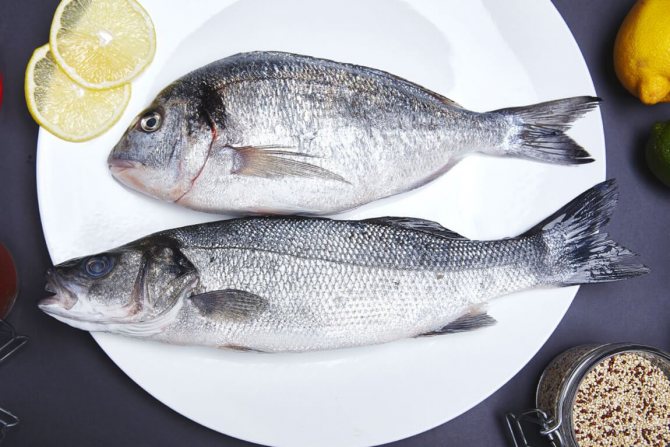
There is a lot of debate among fish lovers about the similarities and differences between crucian carp and sea bass. These fish are practically indistinguishable in taste, but the dorado fillet is denser and more flavorful, while the sea bass is bony.
In terms of the number of useful compounds in its composition, no fish has a pronounced advantage. Both types are interchangeable and have the same medicinal properties.
How to choose and store correctly
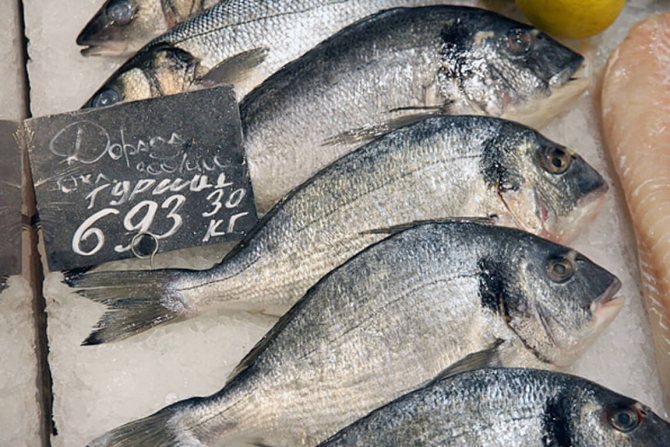
Both frozen and chilled sea bream are found on the shelves. Fish that has not been frozen is preferable, as it is easier to ensure its freshness:
- After light pressure on the back, there is no trace left.
- The gills are red in color, without a putrid odor.
- The tail and fins are elastic.
- The scales are shiny and not weathered.
- The eyes are transparent.
If the carcass has already been cut, it is worth inspecting the fillet. It should be elastic and not fall apart into fibers. The color of fresh pulp is white with a pink tint, without foreign inclusions.
Small specimens 20-40 cm long are the most delicious.
It is better to cook fish immediately. When refrigerated, it can be stored for no longer than 2 days, and when frozen, it can be stored for 4 months.
How to prepare sea bream

Dorado is considered a fish that is almost impossible to spoil during the cooking process. Any processing method is suitable for it: from the most common baking to steaming. Some even eat it raw! Any side dish and sauce goes well with this Mediterranean fish; it is cooked with vegetables, marinated in wine, and a variety of products are used, including mango puree. In each country where dorado is caught or sold, there is its own special recipe, and maybe several recipes. It tastes very similar to sea wolf (sea bass), which is why they are often called interchangeable. Its meat is light, with a pinkish tint, and turns white when cooked. The fish is firm but juicy. Often it is cooked whole, right with the tail and head. There are practically no large seeds in sea bream, but there are a few small ones, so it should be given to children with caution.
What products does it combine with?
Dietary dorado meat is quickly digested and easily absorbed.
To highlight the taste and avoid discomfort after eating, you need to know what delicious product goes best with and what ingredients should not be added to the dish. Compatibility table with other products
| Fine | Ghee, whey, greens, cabbage, carrots, beets, pickles, green vegetables |
| Acceptable | Rice, buckwheat, lemon, quinoa, tomatoes, butter, vegetable oil, pumpkin, eggplant, zucchini |
| Badly | Meat, poultry, eggs, mushrooms, cream, sour cream, lard, nuts, seeds, potatoes, dairy products, cheeses, feta cheese, wheat, rye, oats, bread, peas, chickpeas, mung beans, beans, beans, lentils, |
Cooking secrets
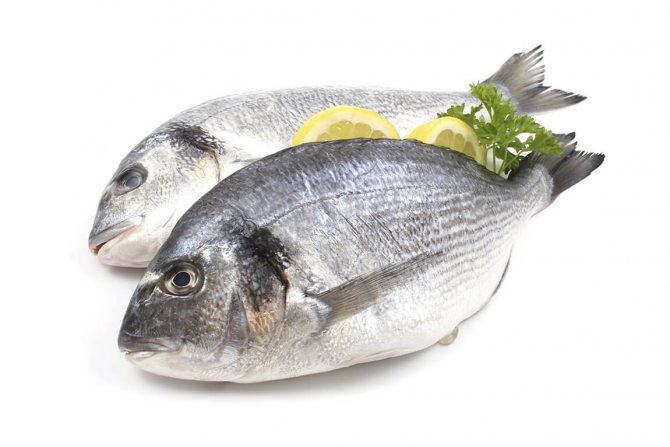
To make the fish tasty, it is important to maintain its juiciness and not dry it out. There are rules for preparing dorado, if followed, the dish will always be a success:
- Before cooking, several cuts are made on the scaled fish. This way the skin will not curl under the influence of temperature.
- It should be stewed in a sauce, preferably made from tomatoes and pickled green olives. This will add piquancy and juiciness.
- If the fish is frozen, place it in a deep bowl and leave it in the refrigerator overnight. You cannot fill it with water or defrost it in a microwave oven, this will ruin the structure and negatively affect the taste.
- The gills are cut out to avoid bitterness in the finished dish.
- It is necessary to observe the temperature regime. It is different for each cooking method.
- Do not overcook fish in the oven. Dorada cooks quickly - from 15 minutes on the grill to half an hour in the oven or in broth.
- To prevent moisture from evaporating during baking, you need to wrap the carcass in foil.
- If you make 3-4 deep cuts on each side, the marinade will more easily penetrate the pulp and soften the small bones.
- Of all the possible spices, Provençal herbs and basil are considered the most suitable. They add a delicious aroma without overpowering the taste.
- No need to cut the fish into steaks. In general, it is much softer and tastier.
In foil
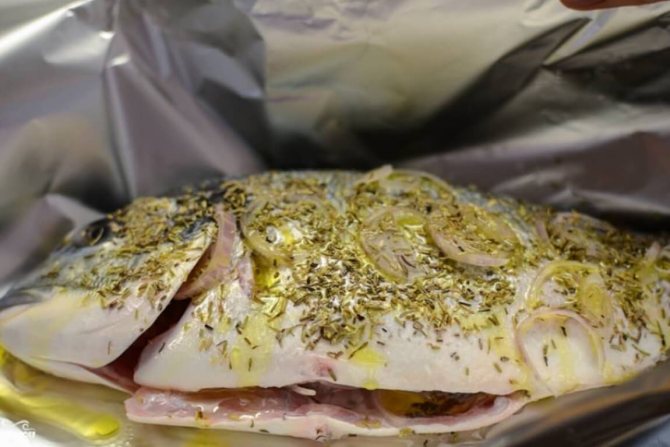
There are various options for preparing dorado in foil. Fish is most often baked, but it turns out no less tasty in a water bath.
Ingredients:
- fish – 2 pcs.;
- olive oil – 3 tbsp;
- dry white wine – 100 ml;
- lemon – 4 slices;
- Provençal herbs – 1 tsp;
- salt to taste.
Preparation:
- Mix the oil with herbs and wine in a deep bowl.
- Coat the prepared carcasses with marinade and leave for 10-15 minutes.
- We put lemon slices into the cuts on the bellies and add salt.
- Wrap each fish tightly in foil.
- Leave to simmer in a water bath for 15-20 minutes.
Italian style in tomato-herb sauce
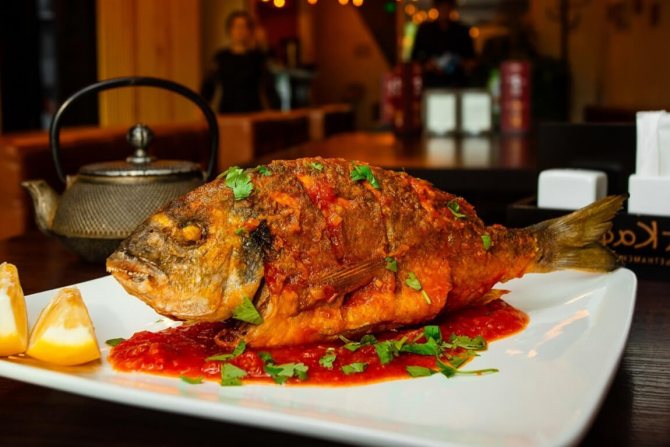
You will need:
- dorado fillet – 4 pcs.;
- pink tomatoes – 500 g;
- cherry tomatoes – 100 g;
- chili pepper – 1 pc.;
- olives – 200 g;
- onions – 1 pc.;
- garlic – 4 cloves;
- basil – 15 g;
- parsley – 10 g;
- flour – 1 tbsp;
- dry white wine – 50 ml;
- salt, ground black pepper - to taste.
Prepare the sauce:
- Cut the onion into cubes and sauté.
- Grind the pink tomatoes in a blender until smooth.
- Add the fried onions to them and send the mixture to simmer over low heat.
- Add a few sprigs of basil and cook until slightly thickened, stirring constantly.
- A couple of minutes before readiness, pepper and salt.
Let's get down to basics:
- If the fillet is large, cut into portions.
- Add some salt, roll in flour, then fry for 3 minutes on each side.
- Finely chop the chili and add to the fish.
- We also put olives and garlic passed through a press there.
- Fry all ingredients over high heat for a minute.
- Reduce temperature, pour in white wine, evaporate.
- Add the prepared sauce to the pan, simmer for 10 minutes, adding cherry tomatoes cut in half.
- Decorate with chopped parsley.
On a bed of salt
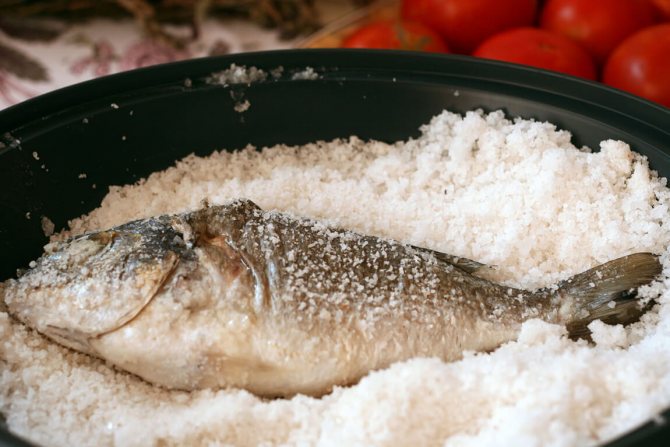
You will need:
- dorado - 1 pc.;
- table salt – 1.5 kg;
- thyme – 2 sprigs;
- rosemary – 2 sprigs;
- lemon – ½ pc.
Preparation:
We gut the fish, remove the gills and wash thoroughly without removing the scales. Dry with a paper towel or napkins.
- Preheat the oven to 200 degrees.
- Pour coarse salt into a large heat-resistant dish in a 1.5 cm layer.
- We cut the lemon into slices and stuff them into the dorada.
- Add herbs to the cut on the abdomen.
- Place the carcass on a bed of salt and bake for 20-30 minutes, depending on the size of the fish.
- Serve with quinoa and bulgur.
How to use when losing weight
Sea crucian is suitable for people who want to significantly reduce their weight, but are not ready to give up delicious food. The fish has a pleasant taste and aroma; no spices are required for its preparation. For dietary nutrition, fish can be prepared in different ways: baked in the oven, grilled, or even eaten raw. Fish is combined with vegetables and rice.
KBJU per 100 g depending on the method of preparation of the product:
| Method of cooking fish | Kilocalories | Squirrels | Fats | Carbohydrates |
| For a couple | 90.9 kcal | 17.8 g | 2.8 g | 0 g |
| Baked in the oven | 144.2 kcal | 14.2 g | 7.8 g | 3.9 g |
| Grilled | 90.7 kcal | 19.8 g | 1.3 g | 0 g |
Dried and smoked
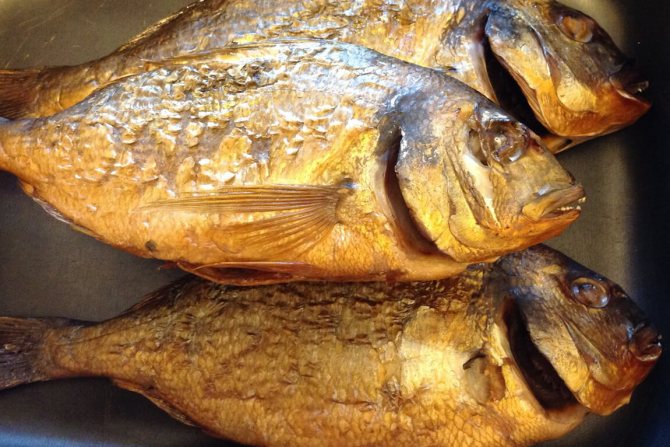
Extraordinarily tasty smoked dorado. With the cold method, the fish will be saltier. It is often used as a beer snack.
Hot-cooked fish melts in your mouth and is eaten with boiled potatoes or as a separate dish.
You can smoke it at home.
In the oven
For the marinade we use dry salting:
- We clean the entrails of 5 small fish without damaging the gallbladder. Remove the gills, head, leave the scales;
- rub the carcasses on top and inside with salt at the rate of 100 g per 1 kg of fish;
- pour 1 cm of salt into a plastic container and place the semi-finished products tightly;
- put pressure on top and leave to marinate for 4 hours;
- We wash the salted fish, insert a wooden spacer into the belly and dry it in air for 3 hours, protecting it from flies with gauze.
For the cold method, we increase the holding time under pressure and drying to 2 days.
Smoking:
- For each fish we prepare foil of a suitable size. Spread it on a baking sheet.
- Lay out the carcasses and water with 1-2 tbsp. liquid smoke.
- Wrap the foil so that the liquid does not leak out.
- In an oven preheated to 200 degrees, place a baking sheet with a small fish for half an hour, with a large fish for an hour.
- Dorado can be dried and dried using the same marinade.
Useful properties of the product
Dorado contains many vitamins, macro and microelements, which have a beneficial effect on the human body. Lovers of healthy eating and adherents of low-carb diets will appreciate fish for its dietary qualities. The nutritional value per 100 grams of sea crucian fish is 98 kcal . BJU ratio (proteins, fats, carbohydrates): 18 g/3 g/0.
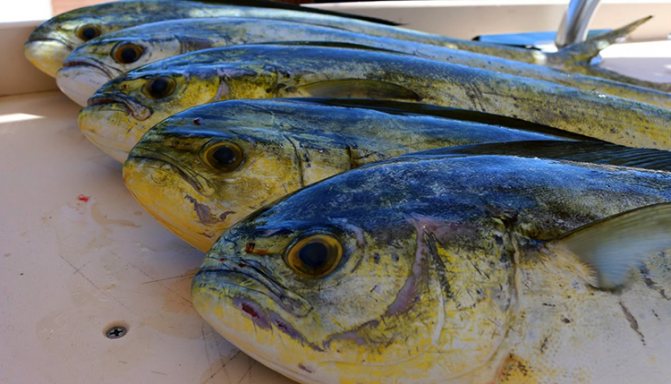
Chemical composition:
Vitamins: A, B1, B2, B5, B6, D9, B12, PP.
Macro and microelements:
- Magnesium.
- Calcium.
- Potassium.
- Sodium.
- Selenium.
- Phosphorus.
- Manganese.
- Iodine.
- Copper.
- Zinc.
Nutrients:
- Squirrels.
- Fats.
- Saturated fatty acids.
- Polyunsaturated fats.
- Monosaturated fats.
- Water.
- Cholesterol.
Dorado meat does not contain carbohydrates, it is recommended for all categories of the population; useful substances will ensure normal functioning of the body.
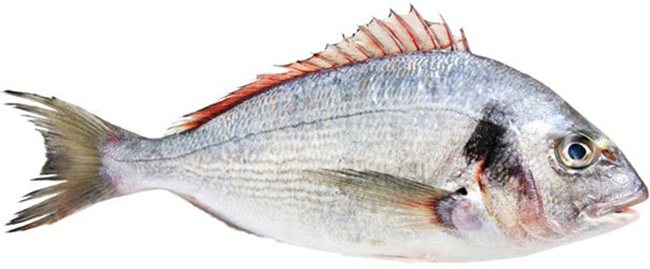
Product benefits:
- Regulates protein, carbohydrate, fat metabolism processes.
- Helps with gastrointestinal diseases.
- Stimulates brain function, improves attention and memory.
- Normalizes the functioning of the thyroid gland.
- Loss of body weight.
- Stabilization of blood sugar levels.
- Regulates the production of hormones.
- Strengthens the heart and blood vessels, bones.
- Improves kidney function.
- Speeds up metabolism.
- Benefits for vision, hair, skin and nails.
With regular consumption of sea crucian fish (at least twice a week), your health will improve.
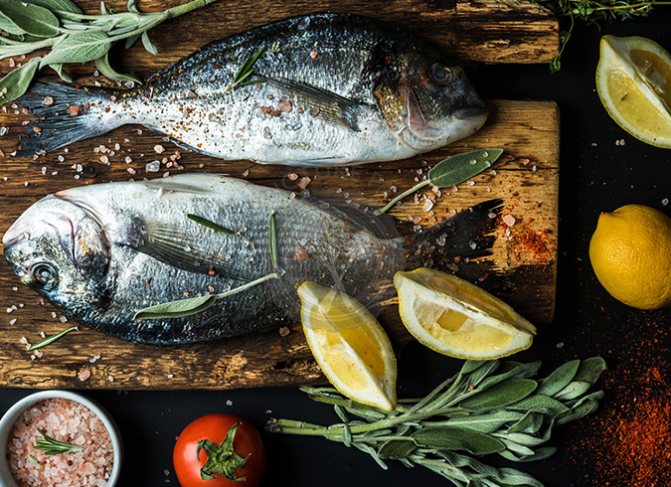
Eating fish during pregnancy contributes to the proper formation of the fetus and supports the body of the expectant mother. Dorado does not contain mercury like other fish species.
It is better to cook dishes by steaming or stewing. The low content of fats that can provoke allergies makes it possible to include sea crucian fish in the diet of nursing women by steaming it with a minimum amount of salt. Start with a small amount; if eaten during the day, the baby will not develop redness, colic, or indigestion; fish can be included in the mother’s menu.
Myths and rumors
In the dorado's habitats, there are many legends and rumors about its mythical properties.
Greece
Locals believe that the golden mark on the forehead was left by the Greek goddess of love. It is believed that Aphrodite gave this fish the power to connect hearts.
If a lover touches the shiny spot three times, then his love will be mutual. In ancient times, lonely people brought fish as a gift to Aphrodite in the hope of finding a soul mate.
Caribbean Islands and Hawaii
The islanders also attribute to the dorado the ability to bring human souls together, calling it a “talisman of love.” There is a ritual - a couple in love must catch the fish themselves, cook it and eat it, sharing it with each other. According to legend, love will grow stronger, and the couple will never part.
This legend is often told to tourists in expensive establishments, offering to catch dorado fish from a restaurant aquarium. You can also fry your catch there, but such a program is not cheap.
History and geography
Dorado, also known as sea bream, golden spar or aurata , gets its name from the obsolete Spanish word "dorado", meaning "gold". Even though the scales of the fish are silvery, people gave it this name because it has a golden stripe between its eyes. The ancient Greeks, who dedicated this small fish to the goddess Aphrodite, also called it the “talisman of love” and believed that by touching its stripe with the index finger three times, one could interrupt a series of love failures and find one’s true soul mate. The more pragmatic Romans, in turn, preferred to feed their soulmate with the “goldfish” they caught with their own hands. The sea bream has one interesting feature: it is a hermaphrodite fish. Young individuals (up to two years old) are male, but over time they increase in size and turn into females. Another interesting fact: in Malta they often sold jewelry with massive fangs of golden spar. They were passed off as snake fangs, which were considered magical.
Dorado lives mainly in the Mediterranean Sea, the Bay of Biscay, the Irish Sea, the North Sea and the waters of the Atlantic Ocean. Recently, it has sometimes been spotted near Crimea, although previously a population of this species had not been observed in the Black Sea. It also has a well-known Pacific namesake, also called coryphaena and popular in Latin America, but there is nothing in common between them except the name itself.
